INTRODUCTION
Trichilia dregeana Sond. (Fig. 1) is an underutilized plant species native to tropical Africa and known for its nutritional and medicinal properties. Trichilia dregeana, commonly known as the forest Natal mahogany belongs to the Meliaceae or the mahogany family. The seeds of T. dregeana have been valued and used in eastern, central, and southern Africa since immemorial times [1]. Once the seed coat has been removed, the seeds are edible and the seed arils are cooked as a condiment or vegetable, and also crushed to yield a milky juice which is taken as a drink [2,3]. The seed oil of T. dregeana is used in various ways. The seed oil is edible and used for cooking, and also used medicinally, as a cosmetic, and for making soap [4,5]. The seed oil has preservative qualities, as the seed oil is boiled with the fruit pulp of Strychnos innocua Delile and stored as reserve food that lasts for at least 2 years [6]. The seed residue that remains after oil extraction is used as animal feed or as fertilizer [1,7]. Research by Van Wyk [8] showed that the seed aril of T. dregeana has potential as a vegetable in South Africa while the seed oil has the potential for producing skin care products as well as pharmaceutical products for rheumatism and other related ailments [9].
Trichilia dregeana is a successful ornamental, shade or street tree in many countries throughout the world, with the tree shape, size, and non-aggressive root system making the species ideal for the garden, parking areas, or habitats near water or watering points in camps [7]. Trichilia dregeana is useful as general-purpose timber, used for carving various wooden items, musical instruments, wooden drums, construction, furniture, household utensils, firewood, and charcoal. The tree is important to a variety of animals for shade, shelter, and above all, for food. The seeds are eaten by many birds [10], and the leaves are browsed by stock and wildlife [1].
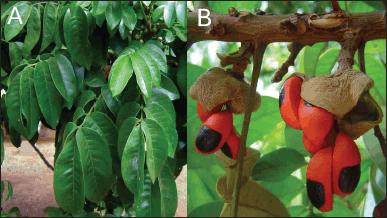 | Figure 1. Trichilia dregeana A: branch showing leaves and B: branch showing fruits (photos: BT Wursten). [Click here to view] |
Trichilia dregeana is a multipurpose species with its different parts used as sources of ecosystem services and goods that are important for human well-being and survival. It is an important source of vegetable oils in tropical Africa [11], characterized by both food values and non-food applications. Seed oil extracted from T. dregeana is of local or regional importance with seeds being sold for soap making in Tanzania while oil from the seeds is used commercially to produce cosmetics, candles, and soap [12]. Since seed oil extracted from T. dregeana is characterized by water-insoluble triacylglycerols and trace amounts of organic compounds such as sterols and antioxidants [11], the species, therefore, is in the same category as castor (Ricinus communis L.), coconut (Cocos nucifera L.), groundnuts (Arachis hypogaea L.), linseed (Linum usitatissimum L.), mustard (Brassica juncea (L.) Czern., rapeseed (Brassica napus L.), sesame (Sesamum indicum L.), soybean (Glycine max (L.), Merr. and sunflower (Helianthus annuus L.) which are the principal sources of vegetable oils in the world [11,13,14]. Recent research shows that vegetable oils are important sources of nutraceuticals such as carotenoids, fatty acids, lignans, phenolics, phytosterols, tocopherols, and tocotrienols [14]. There is also growing demand for edible vegetable oils, with some of them being developed into functional foods, medicinal foods, nutraceuticals, and therapeutic foods aimed at improving human health [15,16]. Trichilia dregeana is a well-known medicinal plant throughout its distributional range, and in the Eastern Cape, Gauteng, and KwaZulu-Natal provinces in South Africa, the bark of the species is sold in informal herbal medicine markets as sources of traditional medicines [17–20]. It is, therefore, within this context that the current study was undertaken aimed at compiling the medicinal, chemical, and pharmacological properties of T. dregeana.
MATERIALS AND METHODS
The literature search on the botany, phytochemistry, and pharmacology of the forest Natal mahogany (Trichilia dregeana Sond.) was conducted from September 2023 to March 2024. This information on these aspects was obtained using online databases such as Scopus® (http://www.scopus.com/), Google Scholar (https://scholar.google.com/), SpringerLink® (https://link.springer.com/), SciELO (https://search.scielo.org/), ScienceDirect® (https://www.sciencedirect.com/search), PubMed® (https://pubmed.ncbi.nlm.nih.gov/), and Web of Science (https://www.webofknowledge.com). Additional information on the botany, phytochemistry, and pharmacology of the forest Natal mahogany (Trichilia dregeana Sond.) was also obtained by a systematic search of various resources that are not covered by electronic databases, and these included journal papers, books, dissertations, book chapters, theses and other scientific articles obtained from the University library. The keywords used in the search included “T. dregeana,” the synonyms of the species “Trichilia dregeana Sond.,” English common names “cape mahogany,” “Christmas bells,” “forest mahogany,” “forest Natal mahogany,” “red ash,” “thunder tree,” and “white mahogany.” An additional search was also conducted using the keywords “biological activities of T. dregeana,” “pharmacological properties of T. dregeana,” “ethnobotany of T. dregeana,” “medicinal uses of T. dregeana,” “phytochemistry of T. dregeana,” and “traditional uses of T. dregeana.”
RESULTS AND DISCUSSION
Morphological description and taxonomy of the species
Trichilia P. Browne is a genus of about 85 cosmopolitan shrub and tree species in the tropics and subtropics, concentrated in America, with 15 species recorded in Africa, and only two in Asia [21]. The two species recorded in southern Africa are T. emetica Vahl and T. dregeana Sond. [22], which are morphologically similar, closely related, and often confused in the field. However, the two species grow under different conditions, fruit and leaf characters are often used to distinguish the two species. Trichilia dregeana grows in high rainfall, evergreen forests, characterized by pointed leaflets that are almost hairless with a smooth lower surface, and fruits with very short and sturdy stalks [10,23,24]. On the other hand, T. emetica often grows in lower rainfall areas in bushland, woodlands, and along river sides. The leaflets of T. emetica are usually rounded while lower surfaces are usually densely hairy and the fruit has a long stalk [10,23,24].
The genus name Trichilia is based on the Greek word “tricho” which means “in three parts” in reference to “3-locular” or “3-celled fruits” [10]. The species name “dregeana” is in honour of a German plant collector, horticulturalist, and botanical explorer, Johann Fran(t)z Drège often referred to as Jean François Drège (March 25, 1794 to February 3, 1881), who visited South Africa between 1826 and 1834, and collected the species in Natal [10]. The synonyms associated with T. dregeana include Trichilia chirindensis Swynnerton and Bak.f., T. dregeana Sond. var. oblonga (Sond.) C.DC., T. dregeana Sond. var. oblonga Sond., T. dregei E.Mey. ex C.DC., T. dregei E.Mey. var. oblonga C.DC., T. grandiflora Oliv., T. ledermannii Harms, T. rekdacta Bullock ex Burtt Davy, T. schliebenii Harms, T. splendida A.Chev., T. strigulosa Welw. ex C.DC., T. stuhlmannii Harms, T. tomentosa A.Chev., T. umbrosa Vermoesen and T. vestita C.DC. and T. vestita C.DC [22–25]. Trichilia dregeana is known by several English common names which include “cape mahogany,” “Christmas bells,” “forest mahogany,” “forest Natal mahogany,” “red ash,” “thunder tree,” and “white mahogany” [10].
Trichilia dregeana is a medium to large dioecious and evergreen tree with a dense and spreading crown growing up to 40 m in height [22]. The tree trunk is tall, straight, and sometimes lightly buttressed and up to 2 m in diameter [10,26]. The main stem has smooth and black bark on young trees and dark grey to brown bark on older stems and branches. The leaves of T. dregeana are opposite or alternate with imparipinnate pairs of leaflets. The leaflets are oblanceolate to obovate in shape, dark glossy green above and paler below with tips more or less sharply pointed. The leaflet has entire margins, hairless below, and leathery with sunken midrib. The flowers are unisexual, similar in appearance, creamy white in color, and pleasantly scented, occurring in terminal and axillary flower heads. The fruit is round in shape, pale green in color, a woody dehiscent capsule, splitting open to reveal `black seeds that are completely enveloped by a bright red aril [3]. Trichilia dregeana has been recorded in Eswatini, Angola, Guinea, Cameroon, Rwanda, Central African Republic, South Sudan, Congo, the Democratic Republic of Congo, Ethiopia, Ivory Coast, Kenya, Zambia, Liberia, Malawi, Uganda, Mozambique, Sudan, Zimbabwe, Tanzania, and South Africa (Fig. 2). Trichilia dregeana has been recorded in montane and riverine forest, transition zone between savanna and forest at an altitude ranging from 15 to 2,000 m above sea level [22–25,27].
Ethnomedicinal significance
Trichilia dregeana is used as a source of traditional medicines in Tanzania, Cameroon, Ethiopia, Mozambique, Zimbabwe, South Africa, and Uganda, that is, 33.3% of the countries where the species is indigenous (Table 2). The traditional medicines prepared from the bark, fruits, leaves, roots, seeds, seed oil, and stem bark of T. dregeana are used to treat and manage 27 human and livestock diseases and ailments in tropical Africa. The main ailments and diseases treated by T. dregeana crude extracts include its use as traditional medicine against intestinal worms, respiratory infections, sores, and wounds which have been recorded in two countries and supported by two literature sources, followed by fever (two country and four literature records), fish poison, lumbago and rheumatism (two country and five literature records), skin problems, laxative and purgative (two country and six literature records), kidney and liver problems (two country and seven literature records), sexually transmitted infections (two country and eight literature records), and gastro-intestinal problems (4 country and 11 literature records) (Fig. 3). Other medicinal applications of T. dregeana supported by at least two literature sources include the use of the bark, fruits, leaves, roots, seeds, seed oil and stem bark as abortifacient, blood purifier, emetic, and tonic, and also as tonic for human immunodeficiency virus/acquired immunodeficiency syndrome (HIV/AIDS) symptoms and traditional medicine for fractures, pain and sleeplessness (Table 1). In South Africa, the leaves of T. dregeana are mixed with those of Albizia adianthifolia (Schumach.) W.Wight as traditional medicine for sexually transmitted infections (gonorrhea and syphilis) [28,29].
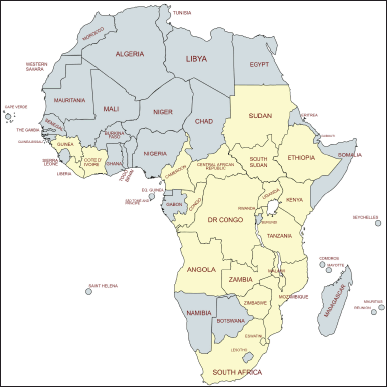 | Figure 2. Distribution of T. dregeana in tropical Africa (map drawn using mapchart.net). [Click here to view] |
Nutritional composition
The seed oil extracted from T. dregeana is nutritious by virtue of having amino acids, fats, fatty acids, and proteins (Table 2), which are comparable to a commercial vegetable oil crop, G. max [57]. In terms of mineral content, seed oil extracted from T. dregeana, species appears to be a good source of essential minerals such as phosphorus, calcium, magnesium, iron, potassium, copper, and sodium [57]. Several fatty acids and amino acids (Table 2) have been identified from the seed oil of T. dregeana [1,57,58]. Compared to conventional vegetable oil crops such as G. max, T. dregeana is a good source of both macro- and micronutrients (Table 2).
Phytochemistry and pharmacological properties of T. dregeana
Several phytochemical compounds such as alcohols, alkanes, amides, esters, lignan, limonoids, sesquiterpenes, steroids, and triterpenoids (Table 3) have been isolated from the leaves, seeds, seed oil, and stems of T. dregeana. Some of the phytochemical compounds isolated from T. dregeana exhibited antibacterial, antifungal, anti-inflammatory, antioxidant, and nitric oxide (NO) production inhibitory activities (Table 4).
Antibacterial and antifungal activities
The medicinal value of T. dregeana against diarrhea, dysentery, scabies, sexually transmitted infections, sores, stomach ache, tinea capitis, toothache, tuberculosis, and wounds could be ascribed to antibacterial properties of phytochemical compounds (3β,23E)-9,19-cyclolanosta-23,25-dien-3-ol and maslinic acid which exhibited activities against Escherichia coli and Salmonella enteritidis with minimum inhibitory concentration (MIC) value of 31.25 μg/ml [61]. The compounds also demonstrated moderate antifungal activities against Candida albicans with a MIC value of 62.5 μg/ml [61]. In addition to these pharmacological effects, ethanol extract of T. dregeana bark and leaves exhibited activities against Staphylococcus aureus with a MIC value of 1.2 mg/ml [65]. Similarly, aqueous and organic extract of T. dregeana leaves exhibited activities against Ureaplasma urealyticum clinical strain with a MIC value of 0.25 mg/ml [66]. Dichloromethane and methanol extracts of T. dregeana bark and leaf exhibited activities against Bacillus cereus, Moraxella catarrhalis, Streptococcus mutans, and Fusobacterium nucleatum subsp. nucleatum with MIC values ranging from 0.25 to 0.50 mg/ml [67].
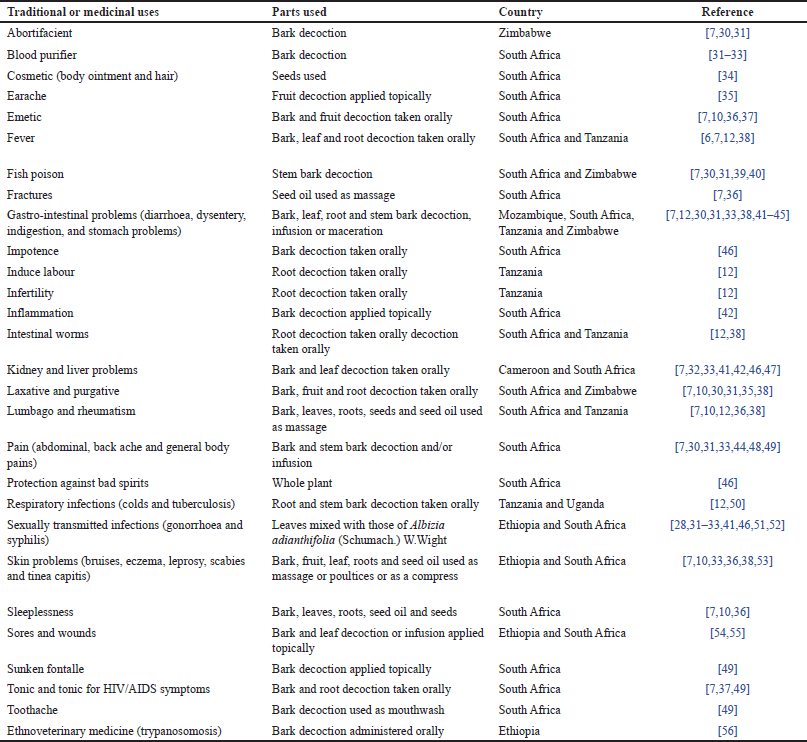 | Table 1. Traditional and ethnomedicinal uses of T. dregeana. [Click here to view] |
Antimycobacterial activities
Ethanol extract of T. dregeana bark exhibited activities against Mycobacterium aurum A+ with a MIC value of 0.78 mg/ml [68] but more ethnopharmacological studies are required as stem bark of the species are used traditionally to treat tuberculosis in Uganda [50].
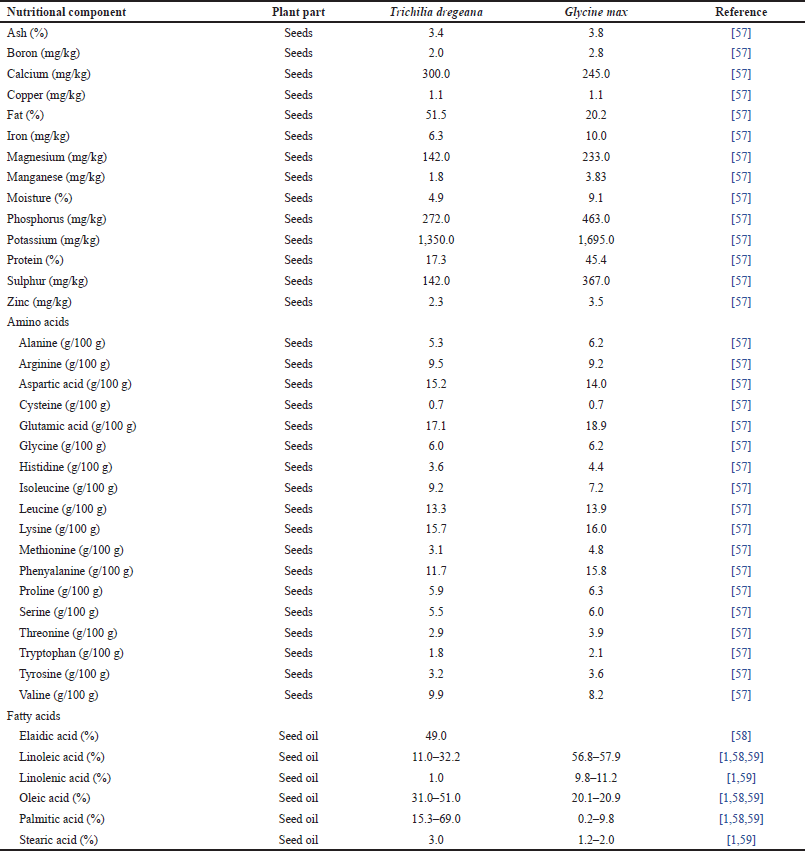 | Table 2. Nutritional composition of T. dregeana and soybean (Glycine max (L.) Merr. [Click here to view] |
Antiviral activities
The methanol extract of T. dregeana roots exhibited activities against hepatitis C virus (HCV) infection with a half maximal inhibitory concentration (IC50) value of 16.2 μg/ml [47]. The use of T. dregeana in treating and managing viral infections is yet to be extensively evaluated scientifically. Possible identification and isolation of active ingredients with antiviral properties is important.
Acetylcholinesterase (AChE) activities
The leaf and twig extracts of T. dregeana exhibited AChE inhibition of 81.1%–94.8% [69] and the ethyl acetate extract of the bark demonstrated moderate activities with IC50 value of 0.8 mg/ml [65]. However, these AChE inhibitory activities are probably due to the phytochemical compound cycloart-23-ene-3,25-diol which exhibited weak activities of 53.0% at a concentration of 0.4 mM [63]. Therefore, future research should focus on searching for AChE inhibitory compounds that characterize T. dregeana as a medicinal plant.
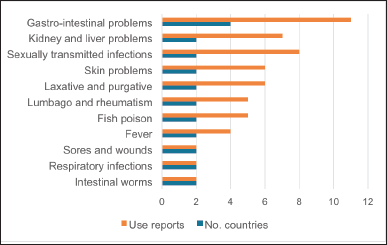 | Figure 3. Main ethnomedicinal applications of T. dregeana in tropical Africa. [Click here to view] |
Anti-inflammatory activities
The ethyl acetate extract of T. dregeana bark and leaves inhibited cyclooxygenase (COX-1) and COX-2) at 78.0% and 81.0%, respectively [65]. Similarly, the phytochemical compound cycloart-23-ene-3,25-diol isolated from the leaves of T. dregeana exhibited activities against COX-1 (56.0%) and COX-2 (80.0%) and IC50 = 97.0 and 40.0 μM, respectively [63]. In in vivo studies, the crude leaf extract also showed anti-inflammatory activities at 100.0, 200.0, and 400.0 mg/kg by inhibiting ear edema, exudate, and granuloma formation [55]. These exhibited anti-inflammatory activities appear to corroborate the ethnomedicinal applications of the bark extracts of the species against inflammation in South Africa [42].
Antioxidant activities
The leaf and twig extracts of T. dregeana showed antioxidant activities against 2,2-diphenyl-1-picrylhydrazyl (DPPH) free scavenging assay exhibiting half maximal effective concentration (EC50) values of 1.3–14.6 µg/ml [69]. Similarly, leaf extract exhibited activities with IC50 values ranging from 11.5 to 27.5 µg/ml using DPPH, 2,2′-azino-bis (3-ethylbenzothiazoline-6-sulphonic acid (ABTS), and ferric reducing antioxidant potential (FRAP) assays [61]. The compound 9,19-cyclolanost-24-en-23-one isolated from the leaves of T. dregeana exhibited activities with IC50 values ranging from 11.9 to 21.3 µg/ml against ABTS, DPPH, and FRAP assays [61]. Therefore, the documented in vitro antioxidant activities exhibited by the extracts and phytochemical compounds isolated from T. dregeana could imply that the species has the capacity to protect animal body cells from harmful damage caused by free radicals.
NO production inhibitory activities
The ethyl acetate extract of T. dregeana leaves inhibited NO production in lipopolysaccharide (LPS)-stimulated RAW264.7 macrophage cells with the IC50 value of 83.5 μg/ml and also the compounds 24ξ-hydroxy-24ξ-methyl-3β,10β-epoxy-19(10→9)abeo-euphan-25-ene and lupenone isolated from the species inhibited NO production in LPS-stimulated RAW264.7 macrophage cells with IC50 values of 81.3 and 85.7 μM, respectively [62]. Demonstration of NO production inhibitory activities by T. dregeana extracts and phytochemical compounds isolated from the species suggest that the species may provide important leads for cancer chemopreventive and anti-inflammatory agents [70].
Prostaglandin-synthesis inhibitory activities
The ethanol extract of T. dregeana bark exhibited 100% prostaglandin-synthesis inhibitory activities [71]. Medicinal plants exhibiting prostaglandin-synthesis inhibitory activities play an important role in treating and managing inflammation and pain-related diseases.
Wound healing activities
In in vivo studies, the crude leaf extract of T. dregeana showed wound healing activities causing wound contraction, decreasing period of epithelialization, and increased tensile strength [55]. Therefore, an increase in wound contraction, reduction in the period of epithelialization, and increase in tensile strength exhibited by T. dregeana extracts corroborate the ethnomedicinal applications of the species as traditional medicine against sores and wounds [54,55].
Insecticidal activities
The acetone extract of T. dregeana leaves showed insecticidal activities exhibiting 71.0% and 65.0% repellence against Spodoptera frugiperda and Plutella xylostella, respectively, with antifeeding deterrent coefficients of 62.0 and 112.3 against the two species [60]. Therefore, this species has the potential to be used as a biocontrol agent against insect pests.
Mutagenicity and toxicity activities
The dichloromethane: methanol (1:1) extracts of T. dregeana bark, leaf, and root exhibited mutagenic activities against Salmonella typhimurium TA100 strain [72]. The aqueous and organic extracts of T. dregeana bark and roots exhibited toxicity activities causing mortality of brine shrimp larvae varying from 75% to 100% after 24 hours [72] and 75% to 95% [73]. The toxic effects of T. dregeana is well-known and the species is categorized as having both poisonous and medicinal properties in the monograph “Medicinal and magical plants of southern Africa: an annotated checklist” [74]. Literature studies revealed that the seedcoat of T. dregeana is poisonous and widely used as fish poison in eastern and southern Africa [7,30,31,39,40], and only well-prepared seed oil is considered as safe for consumption [7]. Similarly, research by Kunene et al. [75] showed that the leaves of T. dregeana are consumed by cattle, goats, and sheep, but the species is known to cause diarrhea and even death of these animals after consuming the leaves [75].
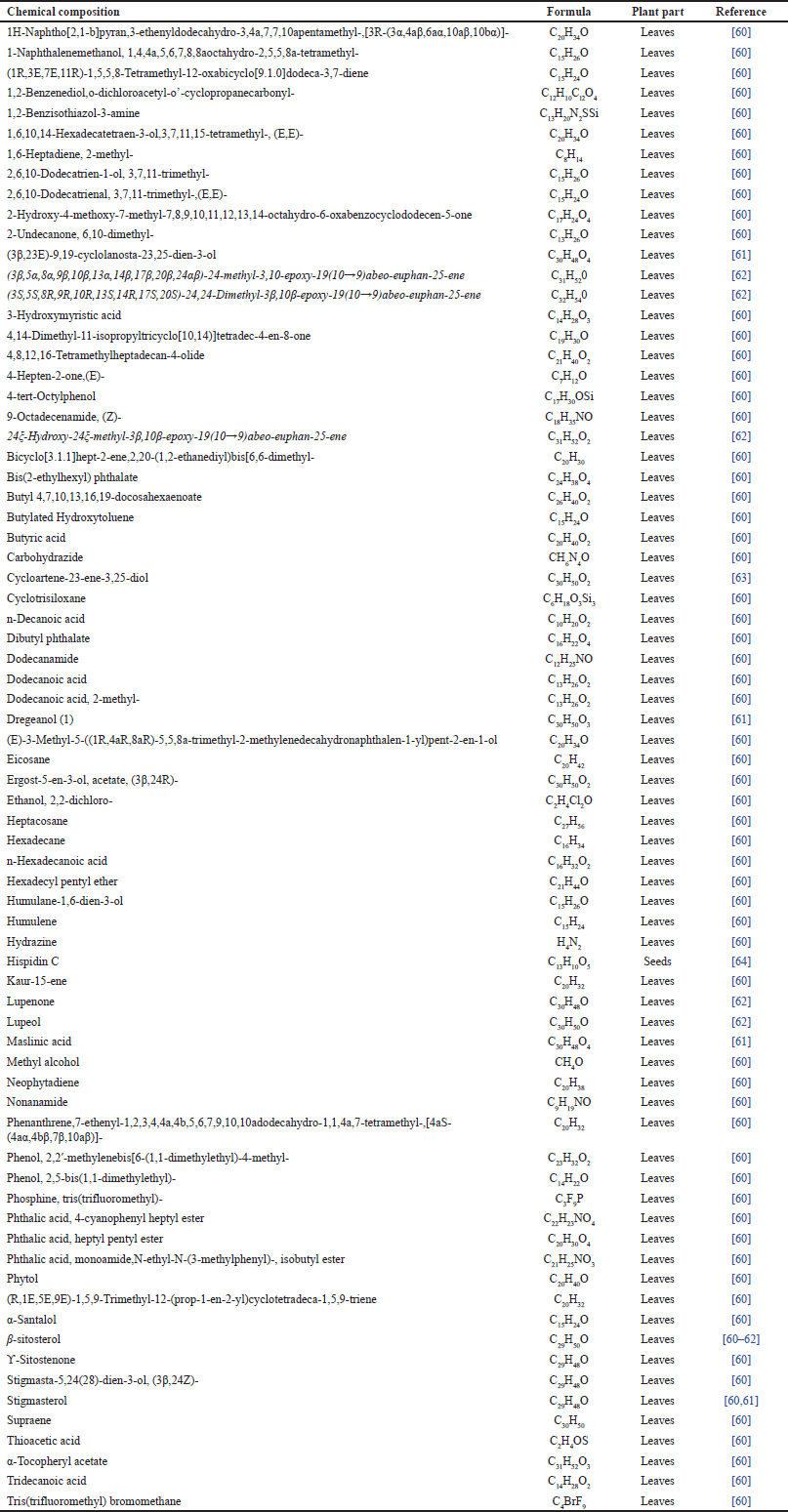 | Table 3. Phytochemical composition of T. dregeana. [Click here to view] |
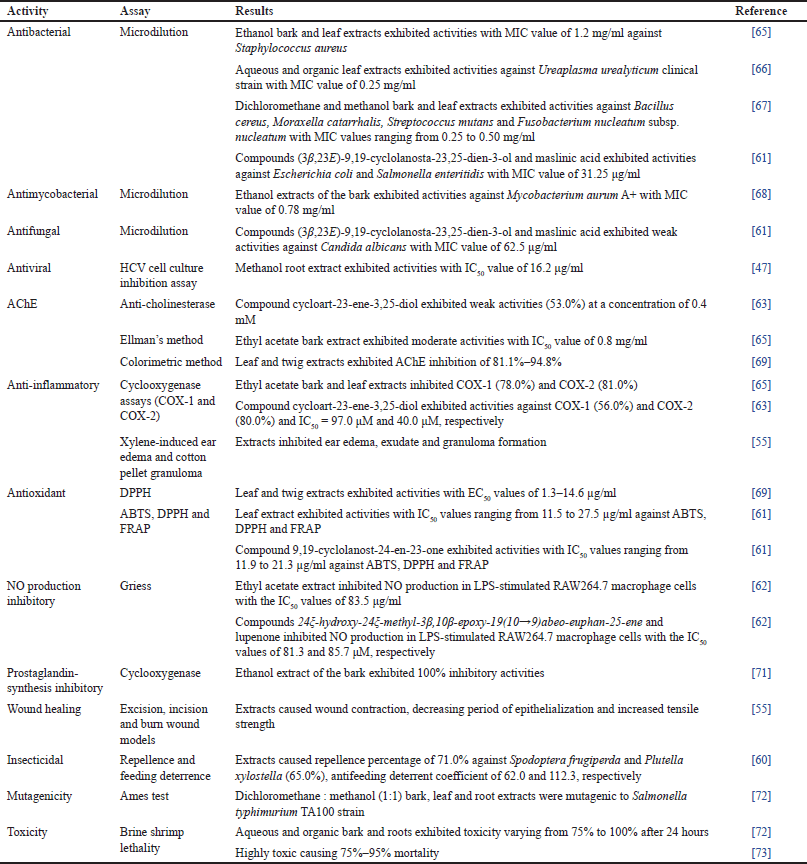 | Table 4. Biological activities of T. dregeana. [Click here to view] |
CONCLUSION
The present review provides a summary of the botany, traditional uses, medicinal applications, and chemical and pharmacological properties of T. dregeana. Such ethnopharmacological studies are important for plant species widely used as sources of traditional medicines as assessing their phytochemistry, pharmacological properties, and toxicological evaluations is important. However, detailed studies focusing on toxicity and safety, mechanisms of action in vivo, and clinical research aimed at corroborating the traditional medical applications of T. dregeana are recommended.
ACKNOWLEDGMENTS
The author appreciates the University of Fort Hare, South Africa, for funding this research.
AUTHOR CONTRIBUTIONS
All authors made substantial contributions to conception and design, acquisition of data, or analysis and interpretation of data; took part in drafting the article or revising it critically for important intellectual content; agreed to submit to the current journal; gave final approval of the version to be published; and agree to be accountable for all aspects of the work. All the authors are eligible to be an author as per the international committee of medical journal editors (ICMJE) requirements/guidelines.
CONFLICTS OF INTEREST
The author declares that there are no conflicts of interest associated with this research work.
ETHICAL APPROVALS
This study does not involve experiments on animals or human subjects.
DATA AVAILABILITY
All data generated and analyzed are included in this research article.
PUBLISHER’S NOTE
All claims expressed in this article are solely those of the authors and do not necessarily represent those of the publisher, the editors and the reviewers. This journal remains neutral with regard to jurisdictional claims in published institutional affiliation.
REFERENCES
1. Grundy IM, Campbell BM. Potential production and utilisation of oil from Trichilia spp. (Meliaceae). Econ Bot. 1993;47(2):148–53. CrossRef
2. Van Wyk B, Van Wyk P, Van Wyke BE. Photographic guide to trees of South Africa. Pretoria, South Africa: Briza Publications; 2000.
3. Van Wyk B, Van Wyk P. Field guide to trees of southern Africa. Pretoria, South Africa: Struik Nature; 2013.
4. Williamson J. Useful plants of Malawi. Zomba, Malawi: University of Malawi; 1974.
5. Tredgold MH. Food plants of Zimbabwe. Gweru, Zimbabwe: Mambo Press; 1986.
6. Watt JM, Breyer-Brandwijk MG. The medicinal and poisonous plants of southern and eastern Africa: being an account of their medicinal and other uses, chemical composition, pharmacological effects and toxicology in man and animal. Edinburgh, UK: E & S Livingstone; 1962.
7. Maroyi A. Trichilia dregeana Sond. In: Van der Vossen HAM, Mkamilo GS, editors. Plant resources of tropical Africa 14: vegetable oils. Leiden, The Netherlands: Backhuys Publishers; 2007. pp. 169–72.
8. Van Wyk BE. The potential of South African plants in the development of new food and beverage products. S Afr J Bot. 2011b;77:857–68. CrossRef
9. Van Wyk BE. The potential of South African plants in the development of new medicinal products. S Afr J Bot. 2011a;77:812–29. CrossRef
10. Palmer E, Pitman N. Trees of southern Africa: covering all known indigenous species in the Republic of South Africa, South-West Africa, Botswana, Lesotho and Swaziland. Cape Town, South Africa: Balkema; 1972.
11. Van der Vossen HAM, Mkamilo GS. Plant resources of tropical Africa 14: vegetable oils. Leiden, The Netherlands: Backhuys Publishers; 2007.
12. Ruffo CK, Birnie A, Tengnäs B. Edible wild plants of Tanzania. Nairobi, Kenya: Regional Land Management Unit (RELMA), Technical Handbook Series 27; 2002.
13. Morya S, Menaa F, Jiménez-López C, Lourenço-Lopes C, Mowyna MNB, Alqahtani A. Nutraceutical and pharmaceutical behavior of bioactive compounds of miracle oilseeds: an overview. Foods. 2022;11:1824. CrossRef
14. Yadav GG, Manasa V, Murthy HN, Tumaney AW. Chemical composition and nutraceutical characterization of Balanites roxburghii seed oil. J Food Comp Anal. 2023;115:104952. CrossRef
15. Fabani MP, Luna L, Baroni MV, Monferran MV, Ighani M, Tapia A, et al. Pistachio (Pistacia vera var. kerman) from Argentinean cultivars: a natural product with potential to improve human health. J Funct Foods. 2013;5:1347–56. CrossRef
16. Labdelli A, Zemour K, Simon V, Cerny M, Adda A, Merah O. Pistacia atlantica Desf., a source of healthy vegetable oil. Appl Sci. 2021;9:2552. CrossRef
17. Cunningham AB. An investigation of the herbal medicine trade in Natal/KwaZulu. Pietermaritzburg, South Africa: Investigational Report Number 29, Institute of Natural Resources; 1988.
18. Cunningham AB. African medicinal plants: setting priorities at the interface between conservation and primary health care. Paris, France: People and Plants Working Paper 1, UNESCO; 1993.
19. Williams VL, Balkwill K, Witkowski ETF. A lexicon of plants traded in the Witwatersrand umuthi shops, South Africa. Bothalia. 2001;31:71–98. CrossRef
20. Dold AP, Cocks ML. The trade in medicinal plants in the Eastern Cape Province, South Africa. S Afr J Sci. 2002;98(11):589–97.
21. Leistner OA. Seed plants of southern Africa: families and genera. Pretoria, South Africa: Strelitzia 10, National Botanical Institute; 2000.
22. Oyedeji-Amusa MO, Stewart RD, Van Der Bank M, Van Wyk BE. A taxonomic review of South African indigenous Meliaceae using molecular systematics and anatomical data. Diversity. 2024;16:113. CrossRef
23. White F, Styles BT. Meliaceae. In: Exell AW, Fernandes A, Wild H, editors. Flora Zambesiaca. Volume 2, part 1. London, UK: Crown Agents for Oversea Governments and Administrations; 1963. pp. 285–319.
24. Styles BT, White F. Meliaceae. In: Polhill RM, editor. Flora of tropical East Africa. Rotterdam, The Netherlands: AA Balkema; 1991. pp. 1–68.
25. De Wilde JJFE. A revision of the species of Trichilia P. Browne (Meliaceae) on the African continent. Wageningen, The Netherlands: Mededelingen Landbouwhogeschool; 1968.
26. Schmidt E, Lötter M, McCleland W. Trees and shrubs of Mpumalanga and Kruger National Park. Johannesburg, South Africa: Jacana; 2017.
27. Germishuizen G, Meyer NL. Plants of southern Africa: an annotated checklist. Pretoria, South Africa: National Biodiversity Institute, Strelitzia; 2003.
28. De Wet H, Nzama VN, Van Vuuren SF. Medicinal plants used for the treatment of sexually transmitted infections by lay people in northern Maputaland, KwaZulu–Natal province, South Africa. S Afr J Bot. 2012;78:12–20. CrossRef
29. Maroyi A. Albizia adianthifolia: botany, medicinal uses, phytochemistry and pharmacological properties. Sci World J. 2018;2018:7463584. CrossRef
30. Gelfand M, Drummond RB, Mavi S, Ndemera B. The traditional medical practitioner in Zimbabwe: his principles of practice and pharmacopoeia. Gweru, Zimbabwe: Mambo Press; 1985.
31. Hutchings A, Scott AH, Lewis G, Cunningham A. Zulu medicinal plants: an inventory. Pietermaritzburg, South Africa: University of Natal Press; 1996.
32. Mabogo DEN. The Ethnobotany of the Vhavenda. Pretoria, South Africa: MSc Dissertation, University of Pretoria; 1990.
33. Burring JH. Trichilia dregeana Sond. Cape Town, South Africa: Kirstenbosch National Botanical Gardens; 2004 [cited 2024 May 12]. Available from: https://pza.sanbi.org/trichilia-dregeana34.Sagbo IJ, Mbeng WO. Plants used for cosmetics in the Eastern Cape Province of South Africa: a case study of skin care. Phcog Rev. 2018;12:139–56. CrossRef
35. Mokganya MG, Tshisikhawe MP, Swelankomo N, Tshivhandekano TR, Ramovha LI, Masevhe NA, et al. An evaluation of additional uses of some wild edible fruit plants of the Vembe District Municipality in the Limpopo province, South Africa. Indian J Trad Knowl. 2018;17(2):276–81.
36. Palgrave MC. Keith Coates Palgrave trees of southern Africa. Cape Town, South Africa: Struik Publishers; 2002.
37. Cocks ML, Dold AP. Cultural significance of biodiversity: the role of medicinal plants in urban African cultural practices in the Eastern Cape, South Africa. J Ethnobiol. 2006;26(1):60–81. CrossRef
38. Van Wyk BE, Van Oudtshoorn B, Gericke N. Medicinal plants of South Africa. Pretoria, South Africa: Briza Publications; 2013.
39. Neuwinger HD. Plants used for poison fishing in tropical Africa. Toxicon. 2004;44:417–30. CrossRef
40. Van Wyk BE, Gericke N. People’s plants: a guide to useful plants of southern Africa. Pretoria, South Africa: Briza Publications; 2018.
41. Arnold HJ, Gulumian M. Pharmacopoeia of traditional medicine in Venda. J Ethnopharmacol. 1984;12:35–74. CrossRef
42. Hutchings A, Van Staden J. Plants used for stress-related ailments in traditional Zulu, Xhosa and Sotho medicine. Part 1. Plants used for headaches. J Ethnopharmacol. 1993;43:89–124. CrossRef
43. Bruschi P, Morganti M, Mancini M, Signorini MA. Traditional healers and laypeople: a qualitative and quantitative approach to local knowledge on medicinal plants in Muda (Mozambique). J Ethnopharmacol. 2011;138:543–63. CrossRef
44. Njume C, Afolayan AJ, Ndip RN. Diversity of plants used in the treatment of Helicobacter pylori associated morbidities in the Nkonkobe municipality of the Eastern Cape Province of South Africa. J Med Plants Res. 2011;5(14):3146–51.
45. Sitoe E, Van Wyk BE. An inventory and analysis of the medicinal plants of Mozambique. J Ethnopharmacol. 2024;319:117137. CrossRef
46. Constant NL, Tshisikhawe MP. Hierarchies of knowledge: ethnobotanical knowledge, practices and beliefs of the Vhavenda in South Africa for biodiversity conservation. J Ethnobiol Ethnomed. 2018;14:56. CrossRef
47. Galani BRT, Sahuc ME, Njayou FN, Deloison G, Mkounga P, Feudjou WF, et al. Plant extracts from Cameroonian medicinal plants strongly inhibit hepatitis C virus infection in vitro. Front Microbiol. 2015;6:488. CrossRef
48. Zukulu S, Dold T, Abbott T, Raimondo D. Medicinal and charm plants of Pondoland. Pretoria, South African: National Biodiversity Institute; 2012.
49. Mhlongo LS, Van Wyk BE. Zulu medicinal ethnobotany: new records from the Amandawe area of KwaZulu-Natal, South Africa. S Afr J Bot. 2019;122:266–90. CrossRef
50. Bunalema L, Obakiro S, Tabuti JRS, Waako P. Knowledge on plants used traditionally in the treatment of tuberculosis in Uganda. J Ethnopharmacol. 2014;151:999–1004. CrossRef
51. Desta B. Ethiopian traditional herbal drugs. Part 2. Antimicrobial activity of 63 medicinal plants. J Ethnopharmacol. 1993;39:129–39. CrossRef
52. De Wet H, Ngubane SC. Traditional herbal remedies used by women in a rural community in northern Maputaland (South Africa) for the treatment of gynaecology and obstetric complaints. S Afr J Bot. 2014;94:129–39. CrossRef
53. Giday M, Asfaw Z, Woldu Z, Teklehaymanot T. Medicinal plant knowledge of the Bench ethnic group of Ethiopia: an ethnobotanical investigation. J Ethnobiol Ethnomed. 2009;5:34. CrossRef
54. Mthethwa NS. Antimicrobial activity testing of traditionally used plants for treating wounds and sores at Ongoye area KwaZulu-Natal, South Africa. Kwadlangezwa, South Africa: MSc Dissertation, University of Zululand; 2009.
55. Shewaye DG, Kahaliw W, Belete TM, Ahmed N. Evaluation of wound healing and anti-inflammatory activities of 80% methanol crude extract and solvent fractions of Trichilia dregeana Sond (Meliaceae) leaves in mice. Evidence-Based Compl Alt Med. 2023;2023:9980866. CrossRef
56. Tamiru F, Terfa W, Kebede E, Dabessa G, Roy RK, Sorsa M. Ethnoknowledge of plants used in veterinary practices in Dabo Hana District, West Ethiopia. J Med Plant Res. 2013;7(40):2960–71. CrossRef
57. Tsomele GF, Venter E, Wokadala OC, Jooste E, Dlamini BC, Ngobese NZ, et al. Structural (gross and micro), physical and nutritional properties of Trichilia emetica and Trichilia dregeana seeds. CyTA J Food. 2021;19(1):483–92. CrossRef
58. Legesse A, Motuma T, Fillipo T, Adrian W, Matthew S. Extraction and characterization of oil from Trichilia dregeana (luya) seed beans and seed shells. J Appl Sci Environ Manag. 2023;27(3):607–14. CrossRef
59. Sultan SM, Dikshit N, Vaidya UJ. Oil content and fatty acid composition of soybean (Glysine max L.) genotypes evaluated under rainfed conditions of Kashmir Himalayas in India. J Appl Nat Sci. 2015;7(2):910–5. CrossRef
60. Shilaluke KC, Moteetee AN. Insecticidal activities and GC-MS analysis of the selected family members of Meliaceae used traditionally as insecticides. Plants. 2022;11:3046. CrossRef
61. Tatio LFF, Bissoue AN, Tcho AT, Akone SH, Jounda NN, Tsopgni WDT, et al. Bioactive constituents from Trichilia dregeana Sond. (Meliaceae). Nat Prod Res. 2024. CrossRef
62. Nguekeu YMM, Kodama T, Matchide MGT, Do KM, Nghokeng J, Tabakam GT, et al. New 19(10 → 9)abeo-euphane-type triterpenoids from Trichilia dregeana leaves and NO production inhibitory activities. Fitoterapia. 2024;176:106001. CrossRef
63. Eldeen IMS, Van Heerden FR, Van Staden J. Biological activities of cycloart-23-ene-3, 25-diol isolated from the leaves of Trichilia dregeana. S Afr J Bot. 2007;73:366–71. CrossRef
64. Mulholland DA, Taylor DAH. Limonoids from the seed of the natal mahogany, Trichilia dregeana. Phytochem. 1980;19:2421–5. CrossRef
65. Eldeen IMS, Elgorashi EE, Van Staden J. Antibacterial, anti-inflammatory, anti-cholinesterase and mutagenic effects of extracts obtained from some trees used in South African traditional medicine. J Ethnopharmacol. 2005;102:457–64. CrossRef
66. Naidoo D, Van Vuuren SF, Van Zyl RL, De Wet H. Plants traditionally used individually and in combination to treat sexually transmitted infections in northern Maputaland, South Africa: antimicrobial activity and cytotoxicity. J Ethnopharmacol. 2013;149:656–67. CrossRef
67. Oyedeji-Amusa MO, Van Vuuren S, Van Wyk BE. Antimicrobial activity and toxicity of extracts from the bark and leaves of South African indigenous Meliaceae against selected pathogens. S Afr J Bot. 2020;133:83–90. CrossRef
68. Eldeen IMS, Van Staden J. Antimycobacterial activity of some trees used in South African traditional medicine. S Afr J Bot. 2007;73:248–51. CrossRef
69. Amoo SO, Aremu AO, Moyo M, Van Staden J. Antioxidant and acetylcholinesterase inhibitory properties of long-term stored medicinal plants. BMC Compl Alt Med. 2012;12:87. CrossRef
70. Cheenpracha S, Park EJ, Rostama B, Pezzuto JM, Chang LC. Inhibition of nitric oxide (NO) production in lipopolysaccharide (LPS)-activated murine macrophage RAW 264.7 cells by the norsesterterpene peroxide, epimuqubilin A. Mar Drugs. 2010;8:429–37. CrossRef
71. Jäger AK, Hutchings A, Van Staden J. Screening of Zulu medicinal plants for prostaglandin-synthesis inhibitors. J Ethnopharmacol. 1996;52:95–100. CrossRef
72. Ngubane SC, De Wet H, Van Vuuren S. Unveiling the potential toxicity and mutagenicity of traditional remedies used for gynaecological and obstetric ailments in Maputaland, South Africa. S Afr J Bot. 2024;168:165–74. CrossRef
73. Van Vuuren S, De Wet H. Exploring African traditional medicine: insights from Northern Maputaland, KwaZulu-Natal, South Africa. Planta Med. 2023;89(14):1372. CrossRef
74. Arnold TH, Prentice CA, Hawker LC, Snyman EE, Tomalin M, Crouch NR, et al. Medicinal and magical plants of southern Africa: an annotated checklist. Pretoria, South Africa: National Botanical Institute, Strelitzia 13; 2002.
75. Kunene N, Wilson RAC, Myeni NP. The use of trees, shrubs and herbs in livestock production by communal farmers in northern KwaZulu-Natal, South Africa. Afr J Range Forage Sci. 2003;20(3):271–4. CrossRef